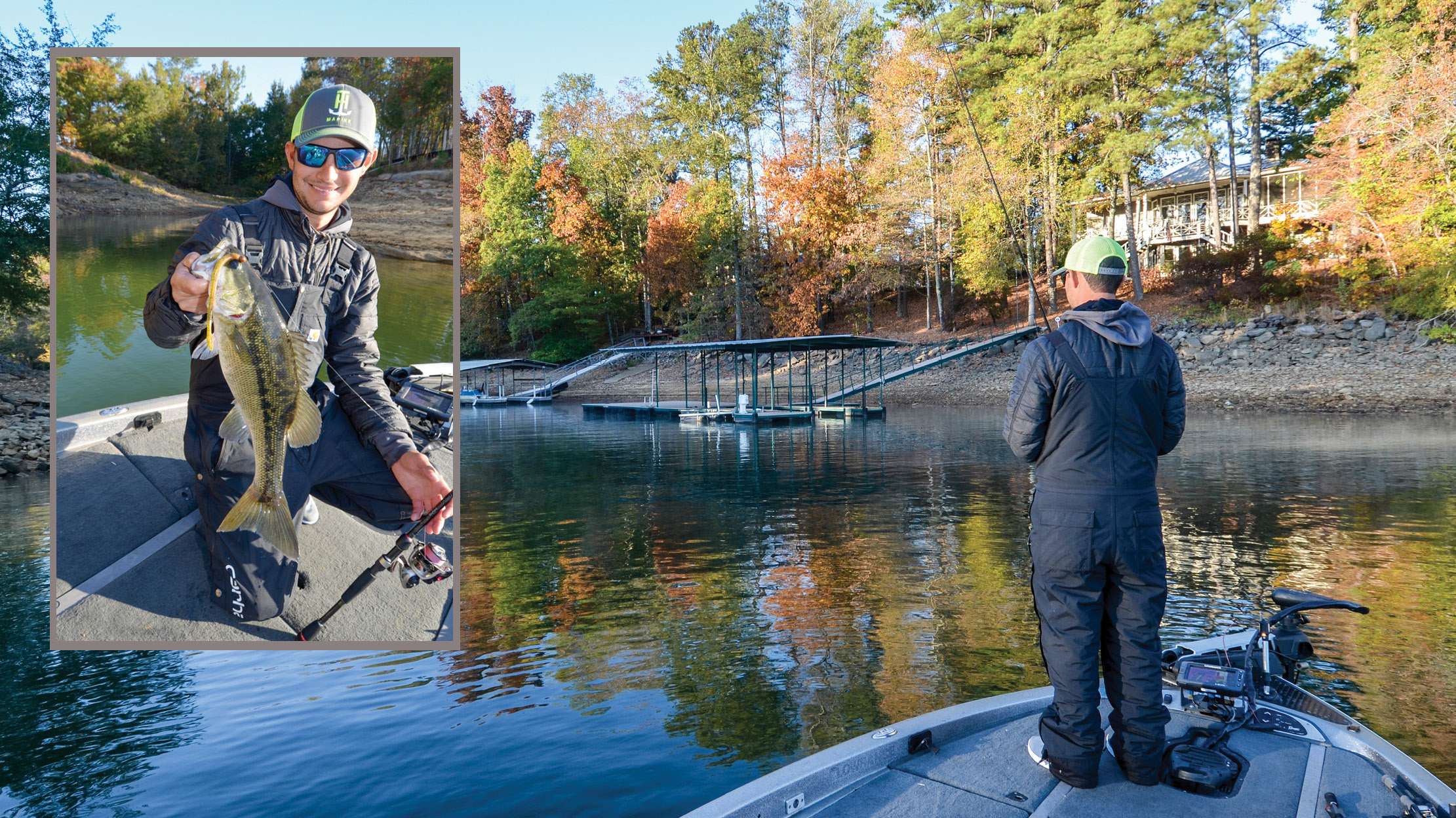
Bassmaster Classic champion Jordan Lee excels at picking off wintertime bass, especially in lakes that have a strong population of spotted bass. He does much of his cold-weather damage by casting a shaky head jig into deep pockets off the main lake.
“Bass in pockets see few lures because most anglers concentrate on points in the winter,” Lee said.

Colder is better
Winter fishing for pocket bass is at its best when the water temperature is below 50 degrees.
“The colder the better, usually,” Lee said. “When the water’s really cold, more bass and bait move into the pockets.”
Lee often finds pocket bass 15 to 25 feet deep, but he has caught them as deep as 40 feet. He cites Georgia’s Lake Lanier and Alabama’s Smith Lake as the type of highland reservoirs where the pocket pattern pays off.
“It can also work to some extent in lakes like Hartwell that have blueback herring, and in California lakes that have predominantly spotted bass,” Lee said.
Bottom huggers
Winter pocket bass also tend to be overlooked because they hug the bottom. This makes them hard to see on sonar units when you’re idling with the outboard. The bass are typically not in large schools, either, Lee added.
“Most of the time there are just a few bass in a pocket,” Lee said. “But they can be the quality fish that win tournaments.”
Rather than look for the bass with the graphs on his console, Lee prefers to let his lures do the job. He says you are also more apt to see the bass and baitfish on a bow graph while fishing than when idling.

“I start out deeper and work in,” Lee said. “They usually bite pretty quick. If I don’t get a bite in five or six throws, I’ll try another pocket.”
Given that highland reservoirs generally have steep banks that plunge into the depths, Lee’s boat is rarely far from the shoreline when he casts. He concentrates on the 15- to 25-foot depth range. Success with this pattern depends on fishing multiple pockets to find the ones that hold bass.
Slow but sure
A 3/16-ounce Strike King round Tour Grade jighead dressed with a 6-inch green pumpkin Strike King KVD Perfect Plastic Finesse worm is Lee’s go-to bait for pocket bass. He casts it with a spinning outfit rigged with 20-pound Seaguar Smackdown braid sporting a 10-foot leader of 8-pound Seaguar InvizX fluorocarbon line.
“You want to fish slow, but don’t overdo it,” Lee said. “I constantly shake the bait, but I never pull it up off the bottom.”
Not limited to spots
The pocket pattern isn’t limited to spotted bass. Elite Series pro Jesse Wiggins of Alabama demonstrated this when he weighed in four hefty limits of smallmouth bass from a single pocket to finish third in an Elite Series tournament at Tennessee’s Cherokee Lake in February 2017.

Wiggins got onto the pocket pattern about five years ago while fishing Smith Lake, Alabama, his home lake, with another angler.
“He showed me the basics of it,” Wiggins said. “I’ve refined it from that point on and expanded on it.”
Wiggins was surprised that other Elite Series pros did not find his productive pocket at Cherokee because he said, “It was so obvious on a map.” What was obvious to Wiggins was that the pocket had a hole-like depression in it that was a magnet for wintertime smallmouth and baitfish.
Like Lee, Wiggins said winter pocket bass are hard to see on sonar units because they belly up to rocky bottoms. If he knows of a pocket that holds bass, Wiggins avoids idling over the fish before casting to them.
Just how far into a pocket the bass will be holding depends on the particular pocket. For spotted bass, Wiggins looks for the 15- to 30-foot depth range. His basic rule of thumb is that the longer the pocket is, the farther into it the bass will be. With a short pocket, he may find the bass only 100 yards from the pocket’s mouth. Bass in a long pocket may be a quarter-mile or more from the main lake.
At the Cherokee Lake tournament, the magic depression that produced four limits of smallmouth bass for Wiggins was 20- to 25-feet deep. The water temperature was in the mid-40s. Wiggins teased the sluggish bass into biting with a 3/8-ounce tungsten ball-head jig dressed with tiny soft plastic minnow imitators, including a 3-inch Jenko Big T, a 3-inch Damiki Armor Shad and a 4-inch Zoom Super Fluke Jr.
When he fishes winter pockets for spotted bass, Wiggins scores with a homemade 3/16-ounce shaky head jig matched with a 6-inch green pumpkin Zoom Trick Worm. He casts this bait with spinning tackle matched with 20-pound Seaguar Smackdown Braid and a 10-foot leader of 12-pound Seaguar InvizX. A 12-pound leader may seem heavy for a finesse presentation, but Wiggins has found no need to use anything lighter.
“There’s nothing special about the baits,” Wiggins said. “It’s all about location, location, location, location.”





